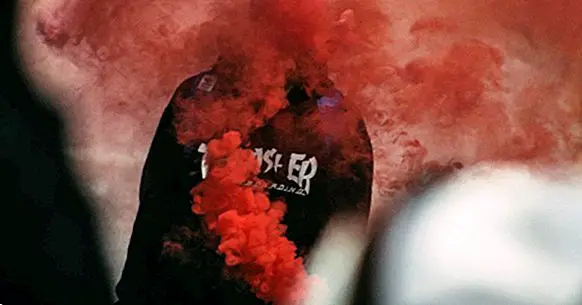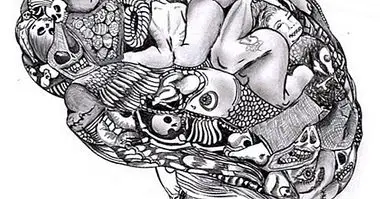Addiction: disease or learning disorder?
When we talk about addictions, we are still somewhat hampered by a moral vision, which points to the addicted person as a selfish, liar and prone to committing crimes. We believe that, in a certain way, he has sought it and does not deserve compassionate treatment .
Faced with this approach full of prejudices, it has been enough for many years that addiction has been added to the list of mental illnesses that must be treated in a healthcare environment. It is understood that the brain of the addict has replaced its "natural" mechanisms, by substances or external behaviors, which make it totally dependent. And we must "cure" it, so that the individual can reintegrate into society. This second option is much more in line with what we know about the addict brain.
However, the transition between these two conceptions has not been completed, and in some ways they are intertwined at times, as in the 12-step programs, those that provide religious communities or opportunistic gurus with miraculous herbs. More and more a different conception gains strength, in which the nature of the addiction is related to a learning problem .
Generating dependency through learning
The consensus reached by the scientific community is that addiction is associated with distorted learning systems in which pleasure is overestimated, risk is underestimated and learning fails after repeating mistakes. Addiction alters an unconscious brain to anticipate exaggerated levels of pleasure or pain reduction (when dependency is consolidated).
What we know about addiction has changed over time. The way in which a drug user becomes addicted or becomes mentally ill is unclear.
In fact, a report by the United Nations Office for Drug Control and Crime (UNODC), states that only 10% of consumers end up having problems with these substances . It is true that it seems intuitive, because if all the people who declare to consume alcohol and drugs, end up being addicted, the number of patients who come to the treatment centers would multiply exponentially.
We are forgetting the entire learning process, which causes the individual to progressively substitute his interests and affections for his addiction. In this way, fortunately, many people discover or learn many other experiences much more rewarding than the consumption of substances. Our interest, from psychology, focuses on those who, despite the fact that there are other, more attractive rewards and despite the harm caused by their addiction, persist in their behavior, reaching dependency.
The neurobiology of addictions
We are talking about a disorder based on the functioning of the brain , that in addicted people works abnormally. But it is not an irreversible degenerative disease; at least, not on most occasions. It is a learning problem that changes the way the brain works, altering its connections through new mechanisms of reward, motivation and punishment. Like other learning disorders, it is also influenced by genetics and the environment throughout our evolutionary process.
As stated by Maia Szalavitz, in his book Unbroken Brain, "science has studied the connection between learning processes and addiction, managing to recognize which brain regions are related to addiction and in what way. These studies demonstrate how addiction alters the interaction between the middle regions of the brain such as the ventral tegmentum and the nucleus accumbens, which are linked to motivation and pleasure, as well as parts of the prefrontal cortex, which help to make decisions and establish priorities. "
One of the functions of these systems, called dopaminergics, is to influence the decisions we make, turning them into rewards, if necessary, increasing the perceived value of them, causing expectations about them. Dopamine, the chemical messenger of pleasure in our brain, responds to primary rewards such as food, water or sex. But it also does secondary rewards like money. In this last case, our expectations play an important role in our brain's response to stimuli. The addiction makes us learn that, if we continue, for example, betting, the probability of winning increases . There is a random negative reinforcement where, in spite of almost never obtaining the anticipated reward, the behavior (betting) is consolidated. Despite losing a lot of money.
The brain altered by the drug
In non-addicted people, the dopamine signal is used to update the value assigned to different actions, which causes a choice and learning. You learn when something unexpected happens.Nothing focuses us more than surprise. We learn by trial and error.
With addiction, this learning process is altered . The signals surrounding the addictive experience are overestimated, causing the dopaminergic systems to assign excessive value to the surrounding contexts. It continues to release dopamine, through the artificial signal that, for example, produce psychoactive substances.
This causes a disproportionate desire for the drug, a desire for consumption that goes far beyond the pleasure or pain relief that can actually produce. In summary, thanks to the distortion in the assessment system of addicted people, their dependence seems to increase desire without increasing the enjoyment of the object of addiction.
As individuals and as a species, it is these brain systems that point us to what matters to us and what does not , being associated with feeding, reproduction and our survival. Addiction distorts these vital goals, substituting them for the purpose of the same, drugs, gambling, sex or even money. It is, in essence, a self-destructive behavior. We could compare it with the engine of a car to which we are degrading, little by little, its fuel with, for example, water. The car will walk with increasing difficulty, and no one will understand why we continue to add adulterated gasoline.
Understanding the context of addiction
If an addicted brain, characterized by focusing on a source of simple satisfaction, we add the social pressure for drug use, for example, or the use of medications that help us regulate our emotions or our affective deficiencies, we will understand how , little by little, the person suffering from an addiction is trapped in it. It's your life, in a way, your comfort zone. However terrible it may seem to us from outside.
To understand all types of self-destructive behaviors, we need a broader conception than the simple idea that drugs are addictive. Addiction is a way of relating to the environment and those who inhabit it. It is a response to an experience that people get from an activity or an object. It absorbs them because it gives them a series of basic and necessary emotional rewards , although it damages your life with the passage of time.
There are six criteria by which we can define an addiction.
1. It is powerful and absorbs our thoughts and feelings
2. Provides essential sensations and emotions (such as feeling good about yourself, or the absence of worry or pain)
3. Produce these feelings temporarily, while the experience lasts.
4. It degrades other commitments, implications or satisfactions
5. It is predictable and reliable
6. By getting less and less of life without addiction, people are forced, in a certain way, to return to the addictive experience as their only form of satisfaction.
It is, as we can see, a full-fledged learning process. Y understanding addiction from this perspective changes things a lot , in addition to modifying quite a lot the approach of the health intervention.
Reversing the learning process
In no case we are considering that, for example, a drug addict can not become a patient with a dual disorder. It happens, sometimes. Let's say that the brain has been pirated so much that it is no longer possible to reinstall the original operating system. But until you get here, The drug addict travels a great path where learning and consolidating new routes in his brain can be modified .
Therefore, although the leap from vice to disease was an important advance in addressing addictions, treating all people who use drugs or are addicted to certain behaviors as patients, may be getting the opposite effect. To treat a learning disorder, such as a phobia, the active participation of the person is essential. It is also essential to know in detail how the disorder has occurred in order to deactivate it.
The same goes for the psychological treatment of the addictive disorder. We have a person in front of us who must replace a noxious behavior with another that is not. And for that it is imperative that you are involved in it from the beginning .
The classic sanitary approach, when classifying all addicts as sick, does not need the collaboration of the same, at least at the beginning. In the case, for example, of drug addiction, the patient is asked not to fight, to be allowed to do it, to detoxify him.
Then we would move on to psychosocial rehabilitation which, until not long ago, was considered an accessory part of the treatment. In a way, to the brain of the drug addict, we are telling him that the solution continues to come from outside and that we will provide it with more psychotropic drugs. Fortunately, we have been evolving towards a treatment that addresses addiction as a learning disorder with biopsychosocial components that have, at least, the same importance.
conclusion
Trying to understand why a person continues to self-destruct even though it has been a long time since the pleasure provided by his addiction disappears, is explained much better as a neuroadaptive learning process, than based on the classic model of disease.
It is a parallel process of unlearning and relearning that requires the active participation of the person to ensure their success . If not, in a certain way, we are reproducing what the addicted brain thinks: that there is an external and quick solution for its discomfort.
The implications of this new approach to treatment are profound. If the addiction is like an unrequited love, in that case the company and the changes in the relational dynamics are a more effective approach than the punishment. The treatments that emphasize the protagonism of the addicted person in their recovery, such as cognitive therapy, with an important motivational component, or the most recent ones, based on Mindfulness, work much better than the traditional rehabilitations in which they are told patients who have no control over their addiction.
In short, if we have known for a long time that only a few people who play, consume alcohol or drugs, become addicted, Is not it time that we consider studying why this happens and that we move away from the maximalist approaches? It is more important to know what protects these people to the point of ending them away from the easy solutions provided by addictions. This will make us design better prevention programs and help us understand where we should direct the treatment processes.



















